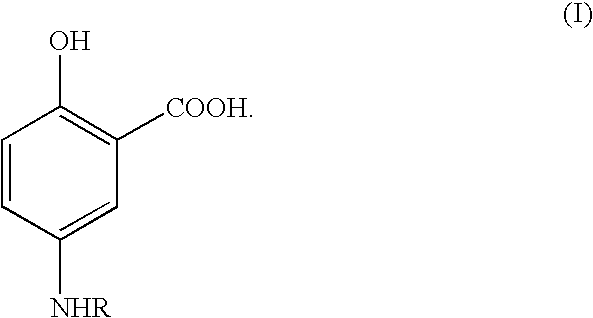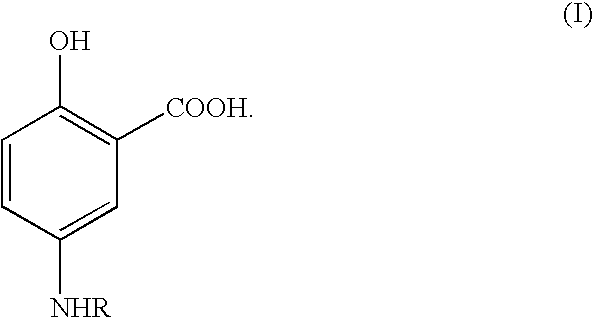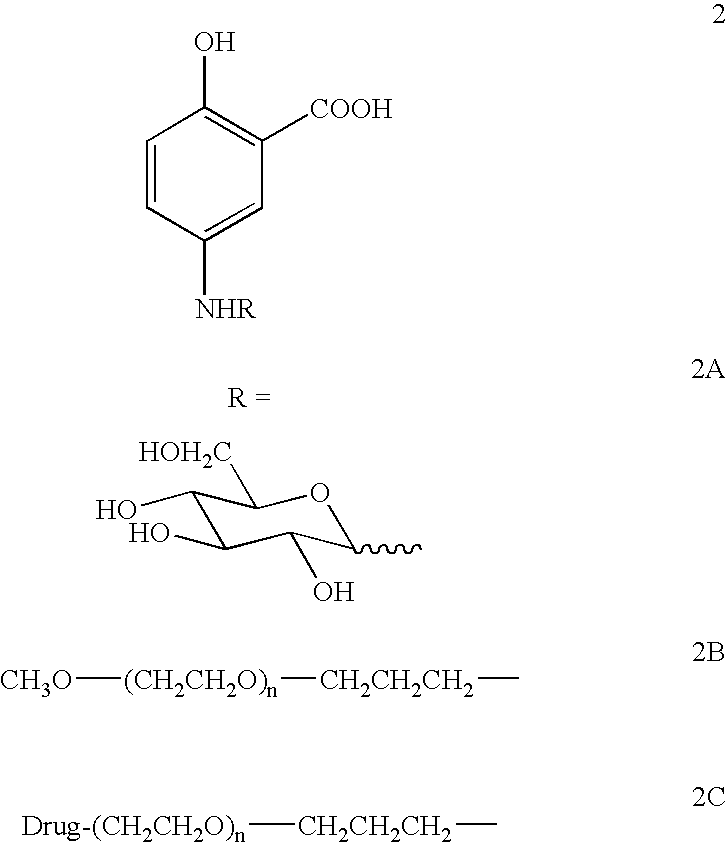Aminosalicylate derivatives for treatment of inflammatory bowel disease
a technology aminosalicylate, which is applied in the field of aminosalicylate derivatives for treatment of inflammatory bowel disease, can solve the problems of salicylate-related safety issues for patients, limited data that are available, and medical science has not yet discovered a cause or cure for ibd, so as to reduce the cellular absorption of said compositions, increase the retention rate, and reduce the effect of transfer
- Summary
- Abstract
- Description
- Claims
- Application Information
AI Technical Summary
Benefits of technology
Problems solved by technology
Method used
Image
Examples
example 1
Preparation of 5-(1-deoxy-D-glycosylamino)salicylic acid
[0070]At least 1.5 mole equivalent of D-(+)-glucose is allowed to react with 5-aminosalicylic acid in methanol / water solution containing 1.1 mole equivalents of triethylamine. The reaction is monitored by thin-layer chromatography (TLC) (silica gel; eluent: CHCl3:MeOH, 1:1, by volume). The solvent is removed, and the reaction mixture is purified by chromatography on silica gel or BIOGEL-F2™ (BioRad, Richmond, Calif.), using absorbance at 254 nm as detection. The products are characterized by TLC on silica gel, electrospray mass spectrometry, and 1H- and 13C-NMR analysis. The transamination reaction is indicated by a downfield shift of resonance of the anomeric proton (observed at δ=4.1 ppm by analysis of unsubstituted D-glucose) to δ=4.3–4.7 ppm in the 1H-NMR spectrum of the β-anomer of the synthetic glycoconjugate product. (This anomer is the major product of the transamination reaction.) This procedure is taken from the repor...
example 2
Preparation of 5-(glycosyl-1′-amino-1′-deoxy)salicylic acid
[0071]Beta-D-glucosylamine is prepared by the reaction of D-(+)-glucose with ammonium bicarbonate as described by Likhosherstov, L. M. et al. (Carbohydr. Res. 146: C1, 1986). A reaction mixture containing the glycosylamine and a 1- to 2-fold excess by weight of 5-aminosalicylic acid is allowed to react overnight in pyridine at 50° C. The reaction is monitored by thin-layer chromatography (TLC) (silica gel; eluent: CHCl3:MeOH, 1:1, by volume). The solvent is removed, and the reaction mixture is purified by chromatography on silica gel or BIOGEL-F2™ (BioRad, Richmond, Calif.), using absorbance at 254 nm as detection. The products are characterized by TLC on silica gel, electrospray mass spectrometry, and 1H- and 13C-NMR analysis. The transamination reaction is indicated by a downfield shift of resonance of the anomeric proton (observed at δ=4.1 ppm by analysis of the unsubstituted glycosyl-1-amine) to δ=4.3–4.7 ppm in the 1H-N...
example 3
Preparation of Other Glycoconjugates of 5-Aminosalicylic Acid
[0072]Glycoconjugates containing 5-aminosalicylic acid are obtained from other 1-amino-1-deoxysugars derived from glucose, mannose, fucose, galactose, cellobiose, maltose, lactose, N,N-diacetylchitobiose, and N-acetyllactosamine, for example, are prepared as described in Examples 1 and 2. Purity of the glycoconjugates is verified by reversed-phase HPLC [SPHERISORB C18 (5 m particle size) column (Alltech, Deerfield, Ill.)] using isocratic delivery of a mobile phase consisting of 20% aqueous acetonitrile. The products are characterized by TLC on silica gel, electrospray mass spectrometry, and 1H- and 13C-NMR analysis. The transamination reaction is indicated by a downfield shift of resonance of the anomeric proton (observed at 6=4.1 ppm by analysis of the unsubstituted glycosyl-1-amine) to δ=4.3–4.7 ppm in the 1H-NMR spectrum of the β-anomer of the synthetic glycoconjugate product. (This anomer is the major product of the tr...
PUM
| Property | Measurement | Unit |
|---|---|---|
| concentrations | aaaaa | aaaaa |
| concentrations | aaaaa | aaaaa |
| pH | aaaaa | aaaaa |
Abstract
Description
Claims
Application Information
 Login to View More
Login to View More - R&D
- Intellectual Property
- Life Sciences
- Materials
- Tech Scout
- Unparalleled Data Quality
- Higher Quality Content
- 60% Fewer Hallucinations
Browse by: Latest US Patents, China's latest patents, Technical Efficacy Thesaurus, Application Domain, Technology Topic, Popular Technical Reports.
© 2025 PatSnap. All rights reserved.Legal|Privacy policy|Modern Slavery Act Transparency Statement|Sitemap|About US| Contact US: help@patsnap.com



